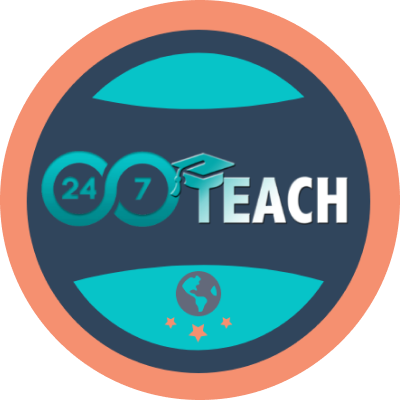Lesson 3: The Four Types of Academic Writing
Prefer to listen to this lesson? Click below.
Workshop Scenario:
Please think of yourself in the following scenario as you complete this workshop:
You are a student working part-time as a writing tutor. A college student named Hannah approaches you for help.
She mentions that she is struggling with her academic writing and expresses frustration with her recent essays, which she feels are poorly structured and lack clarity. She strongly desires to improve her writing skills but feels overwhelmed by the expectations of academic writing.
As you progress through this 24/7 Teach Workshop, you feel you have a firm grasp on the foundational concepts of academic writing and essay structuring. You now wonder if what you have learned so far can be applied to different types of academic writing, so you dive into this lesson with vigor.
Today, you will learn about the different types of academic writing. Please take notes throughout the lesson, as you will need to refer to them in your closing assessment.
Lesson Objective:
Your objective for today is to discover how to effectively apply the different types of academic writing.
As you read, please consider the following questions:
What information should you consider when evaluating the quality of a piece of academic writing?
Think of a topic you have studied in school. How might you use analytical writing to break down and explain different components of that topic?
Lesson 3: The Four Types of Academic Writing
Academic writing can be broadly categorized into four types: descriptive, analytical, persuasive, and critical. These four types of academic writing differ in their purpose, style, and the kind of analysis that they employ. In this lesson, we will explore each type of academic writing and what makes them unique.
3.1 Descriptive Writing
Descriptive writing is like a painting with words. It allows you to create a vivid and detailed picture in your reader's mind. Whether you're describing a person, place, object, or event, the purpose of descriptive writing is to transport the reader to that particular moment in time and help them experience it through your eyes.
Purpose and Features
Descriptive writing can be used in a variety of settings, from creative writing to academic writing. In literature, it helps to create memorable characters and vivid settings that readers can relate to. In scientific writing, descriptive writing is used to describe the results of experiments, the characteristics of a particular specimen, or the features of a new discovery.
In academic writing, descriptive writing is often used in fields such as history and the humanities, where the focus is on describing objects, people, or events. The writer must provide specific details and use language that is appropriate for the audience and purpose. This type of writing can help to bring the past to life and make historical events more accessible to the reader.
Example of Effective Descriptive Writing
Here is an example of effective descriptive writing in academic literature, taken from an article in the field of psychology:
"Participants in the experimental group were asked to recall a traumatic event from their past, while those in the control group were asked to recall a neutral event. The trauma group showed significantly higher levels of physiological arousal, as measured by heart rate and skin conductance, compared to the control group. Furthermore, participants in the trauma group reported higher levels of anxiety and distress on self-report measures and displayed more avoidant behaviors during a subsequent behavioral task."
In this example, the author uses sensory details to describe the experimental procedure, including the specific instructions given to the participants, the measurements taken, and the observed behavioral responses.
The language is precise and concise, with no unnecessary details or jargon, and the structure of the sentences is clear and organized. The descriptive writing effectively communicates the results of the study and helps the reader to understand the significance of the findings.
3.2 Analytical Writing
Academic analytical writing is like detective work, but instead of solving crimes, you are solving intellectual puzzles. Analytical writing aims to break down complex ideas or data into smaller, more manageable parts and examine each part in detail. The goal is to identify patterns, connections, and causes and to draw conclusions based on evidence.
Purpose and Features
One of the key features of analytical writing is its use of data and evidence. Analytical writers rely on empirical evidence, data, and statistics to support their arguments. This requires a deep understanding of the subject matter and the ability to critically evaluate sources of information.
Another feature of analytical writing is its focus on logic and reasoning. Analytical writers use deductive or inductive reasoning to draw conclusions based on evidence. They also use critical thinking to identify assumptions and logical fallacies and question arguments' validity.
Example of Effective Analytical Writing
In his article "The American Dream: Dead, Alive, or on Hold?" (2014), sociologist Brandon King analyzes the changing nature of the American Dream in the 21st century. He writes:
"Although the American Dream remains an enduring concept in the United States, its realization has become more elusive in recent years. As the gap between the rich and the poor widens, many Americans find themselves trapped in a cycle of economic insecurity and social immobility. Despite the rhetoric of opportunity and hard work, the data suggest that the American Dream is no longer attainable for a growing number of people."
King's analytical approach is effective for several reasons. First, he establishes a clear thesis statement in the opening paragraph and provides a roadmap for the article. He also supports his argument with specific evidence and data, which lends credibility to his claims.
Additionally, he uses clear and concise language, avoiding jargon or technical terms that might obscure his meaning. Finally, he acknowledges alternative viewpoints and objections but ultimately argues persuasively in favor of his own position.
3.3 Persuasive Writing
Academic persuasive writing is a powerful tool used by scholars and students to convince their readers to accept their viewpoint, argument, or position.
Purpose and Features
The purpose of academic persuasive writing is to engage the reader with a well-reasoned and well-supported argument designed to influence their beliefs, attitudes, or actions.
One of the key features of academic persuasive writing is the use of evidence and logical reasoning to support the argument being made. A good academic persuasive essay will present facts, statistics, and other types of evidence to support the writer's argument and will use logical reasoning to show how the evidence supports the conclusion.
Academic persuasive writing also requires a clear understanding of the target audience. A good writer will understand their readers' values, beliefs, and attitudes and will tailor their argument to appeal to these specific characteristics. This requires a deep understanding of the target audience and the ability to craft a persuasive argument that is both compelling and relevant to the reader.3.3 Persuasive Writing
Example of Effective Persuasive Writing
The paper "Why Students Should Be Encouraged to Study Abroad" by Diane Smith argues that studying abroad provides numerous benefits for students. Smith presents evidence from previous studies and personal anecdotes to support her argument and uses clear and concise language to make her points. For example, Smith writes:
"Research has shown that students who study abroad are more likely to develop cross-cultural understanding and empathy, which are important skills in today's globalized world. In addition, studying abroad can lead to personal growth and increased self-confidence, as students learn to navigate new environments and challenges."
Through her persuasive writing, Smith aims to convince the reader that studying abroad is a valuable experience that students should be encouraged to pursue. By presenting a clear and well-supported argument, she is able to engage the reader's interest and persuade them to consider her point of view.
3.4 Critical Writing
As a scholar or student, you can question assumptions, explore alternative perspectives, and drive the advancement of knowledge through critical writing. With its emphasis on rigorous analysis, logical arguments, and evidence-based reasoning, critical writing enables you to become an explorer of the unknown and a powerful contributor to the ongoing discourse of intellectual inquiry.
Purpose and Features
So what are the key features of academic critical writing? It's all about deep engagement with the subject matter, clear and coherent argumentation, and a willingness to question authority and explore alternative perspectives. Critical writing requires you to dig deep into the evidence, challenge established ideas, and arrive at a well-supported conclusion through the use of logical arguments and counterarguments.
Critical writing also involves a deep engagement with alternative perspectives and a willingness to question assumptions and biases. This means being open to new and transformative ideas, exploring multiple perspectives on a given issue, and ultimately pushing the boundaries of knowledge and driving intellectual inquiry forward.
Example of Effective Critical Writing
In her article "The Gendered Politics of Power: A Case Study of Women in Leadership," Diane Coleridge argues that the traditional view of leadership in organizations is inherently biased against women. She notes:
“The masculine traits of assertiveness and competitiveness are often viewed as necessary for effective leadership, while feminine traits such as empathy and collaboration are often overlooked. Case studies of women in leadership positions have revealed that they often face significant barriers to success. For example, they may be judged more harshly for mistakes or perceived weaknesses than their male counterparts or excluded from informal networks of power and influence.”
Coleridge's critical analysis of the gendered politics of power is persuasive and well-supported. She draws on a range of sources, including interviews with female leaders, to illustrate her points and present a compelling argument. By taking a critical approach to the issue of women in leadership, Coleridge can highlight how gender bias operates in organizational settings and suggest strategies for change.
In Conclusion
By mastering these different types of writing, writers can effectively communicate their ideas and findings to their intended audiences, and advance knowledge and understanding in their fields.
So whether you're painting a picture with words, analyzing complex data sets, advocating for a particular viewpoint, or challenging conventional wisdom, there is a type of academic writing that can help you achieve your goals and make a meaningful contribution to your field.
Closing Assessment:
Now that you have reached the end of this lesson, you should be able to answer the following:
What is the main difference between descriptive writing and critical writing?
Think of a topic you have studied in school. How might you use analytical writing to break down and explain different components of that topic?
Participate in the 24/7 Discussion Forum
Please answer the following question in the comment section below and interact with learners from around the world:
Imagine that you are trying to persuade a friend to support a particular policy or idea. What strategies would you use to create a convincing argument, and how would you structure your writing?
Please read and reply to other learners’ answers in the forum.
Course created by: Sarah Moutaoukil, a 24/7 Instructional Design Superstar













